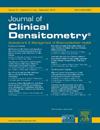Pediatric Lateral Distal Femur Reference Ranges for Ages 1 to 18 years
IF 1.6
4区 医学
Q4 ENDOCRINOLOGY & METABOLISM
引用次数: 0
Abstract
Introduction: Many children with musculoskeletal disorders are at high risk of fracture, and the lateral distal femur (LDF) may be the only feasible site to measure bone mineral density (BMD) by dual energy X-ray absorptiometry (DXA). Pediatric reference ranges and adjustment for linear growth are needed to interpret BMD results.
Methods: Lateral distal femur scans by DXA were obtained on children, ages 1 to 18 y, from two clinical centers. Precision in young children was estimated from duplicate scans. Smoothed reference ranges for three regions of the LDF were generated. Prediction equations were developed to account for the effects of short or tall stature on BMD.
Results: We obtained >2400 measurements on 1,245 children and generated reference ranges for three LDF BMD regions. Precision of BMD was similar (% CV of 1.33 to 2.42 %) to estimates reported at other skeletal sites. Modest sex differences were observed, with females having greater BMD than males at older ages. Children identified as Black had greater BMD than children identified as Non-Black. Height-for-age Z-scores were associated with BMD-for-age Z-scores in pre- and peri-pubertal children, and adjustment equations were generated.
Conclusions: This study fills substantial gaps in pediatric bone health assessment for children with musculoskeletal disorders who are at high-risk of fracture by providing smoothed reference ranges for ages 1 to 18 y and equations to estimate the impact of small body size on BMD-for-age Z-scores.
1至18岁儿童股骨外侧远端参考范围
导读:许多患有肌肉骨骼疾病的儿童骨折风险高,股骨外侧远端(LDF)可能是双能x线骨密度仪(DXA)测量骨矿物质密度(BMD)的唯一可行部位。需要儿童参考范围和线性生长调整来解释骨密度结果。方法:通过DXA对来自两个临床中心的1至18岁的儿童进行外侧股骨远端扫描。通过重复扫描估计幼儿的精确度。生成了LDF的三个区域的平滑参考范围。开发了预测方程来解释矮或高的身材对骨密度的影响。结果:我们对1245名儿童进行了2400次测量,并生成了三个LDF BMD区域的参考范围。BMD的精度与其他骨骼部位的估计相似(% CV为1.33至2.42 %)。观察到适度的性别差异,老年女性的骨密度高于男性。黑人儿童的骨密度高于非黑人儿童。在青春期前和青春期周围儿童中,身高年龄z分数与骨密度年龄z分数相关,并生成调整方程。结论:本研究通过提供1 - 18岁的平滑参考范围和估算小体型对年龄骨密度z分数影响的方程,填补了骨折高危肌肉骨骼疾病儿童骨骼健康评估的实质性空白。
本文章由计算机程序翻译,如有差异,请以英文原文为准。
求助全文
约1分钟内获得全文
求助全文
来源期刊

Journal of Clinical Densitometry
医学-内分泌学与代谢
CiteScore
4.90
自引率
8.00%
发文量
92
审稿时长
90 days
期刊介绍:
The Journal is committed to serving ISCD''s mission - the education of heterogenous physician specialties and technologists who are involved in the clinical assessment of skeletal health. The focus of JCD is bone mass measurement, including epidemiology of bone mass, how drugs and diseases alter bone mass, new techniques and quality assurance in bone mass imaging technologies, and bone mass health/economics.
Combining high quality research and review articles with sound, practice-oriented advice, JCD meets the diverse diagnostic and management needs of radiologists, endocrinologists, nephrologists, rheumatologists, gynecologists, family physicians, internists, and technologists whose patients require diagnostic clinical densitometry for therapeutic management.
 求助内容:
求助内容: 应助结果提醒方式:
应助结果提醒方式:


